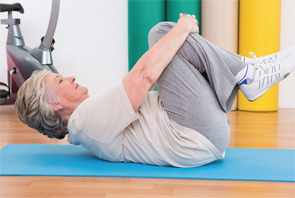
The pain of knee OA can make exercises challenging.
Image Credit: Alice Day/shutterstock.com
Millions of adults suffer from painful knee osteoarthritis (OA). Although physical activity can help improve pain and reduce functional limitations, many people with OA are physically inactive. For people living with knee OA, it can be difficult to get started with or continue on a physical activity program, because pain and other symptoms can make some exercises very challenging. For this reason, it’s important to provide patients with knee OA with guidance and support for an appropriate physical activity program.
Physical Therapy for Knee OA
Visits to physical therapists are one important source for this kind of instruction. Physical therapists can provide guidance on a home exercise program that fits the needs and abilities of each patient with knee OA, including direction on progressing the exercises. Along with this, physical therapists can evaluate whether patients with knee OA could benefit from mobility aids or other devices to address biomechanical issues.
Some studies have shown that physical therapy is an underutilized service among patients with knee OA. Some patients lack health insurance, cannot afford co-payments or live in medically underserved areas where physical therapy services are limited. Thus, there’s a need to develop and test other resources that can provide guidance and support for physical activity tailored for people with knee OA.
The PATH-IN Study
A new study, the PhysicAl THerapy vs. INternet-based Exercise Training for Patients with Knee OA (PATH-IN), is evaluating a newly developed, Internet-based exercise program for people with knee OA.1 The PATH-IN study is based at the Thurston Arthritis Research Center at the University of North Carolina at Chapel Hill, with collaborators at Duke University Medical Center, and is funded by the Patient-Centered Outcomes Research Institute.
PATH-IN is a pragmatic comparative effectiveness trial, in which patients with knee OA are being randomized to usual care physical therapy, an Internet-based exercise training program or a waitlist control group that receives treatment at the end of study participation. The study will examine the effectiveness of each intervention for improving pain and functional outcomes at four-month and 12-month assessment visits. The study will also assess whether the Internet-based exercise training program is as effective as physical therapy, a guideline-recommended component of care for knee OA. If the Internet-based exercise training program is found to be as helpful for knee OA, this would be another treatment option for patients who may not have access to, or be able to afford, physical therapy. This study will also determine whether the Internet-based exercise program is more effective for patients who have certain characteristics (e.g., milder joint disease).

